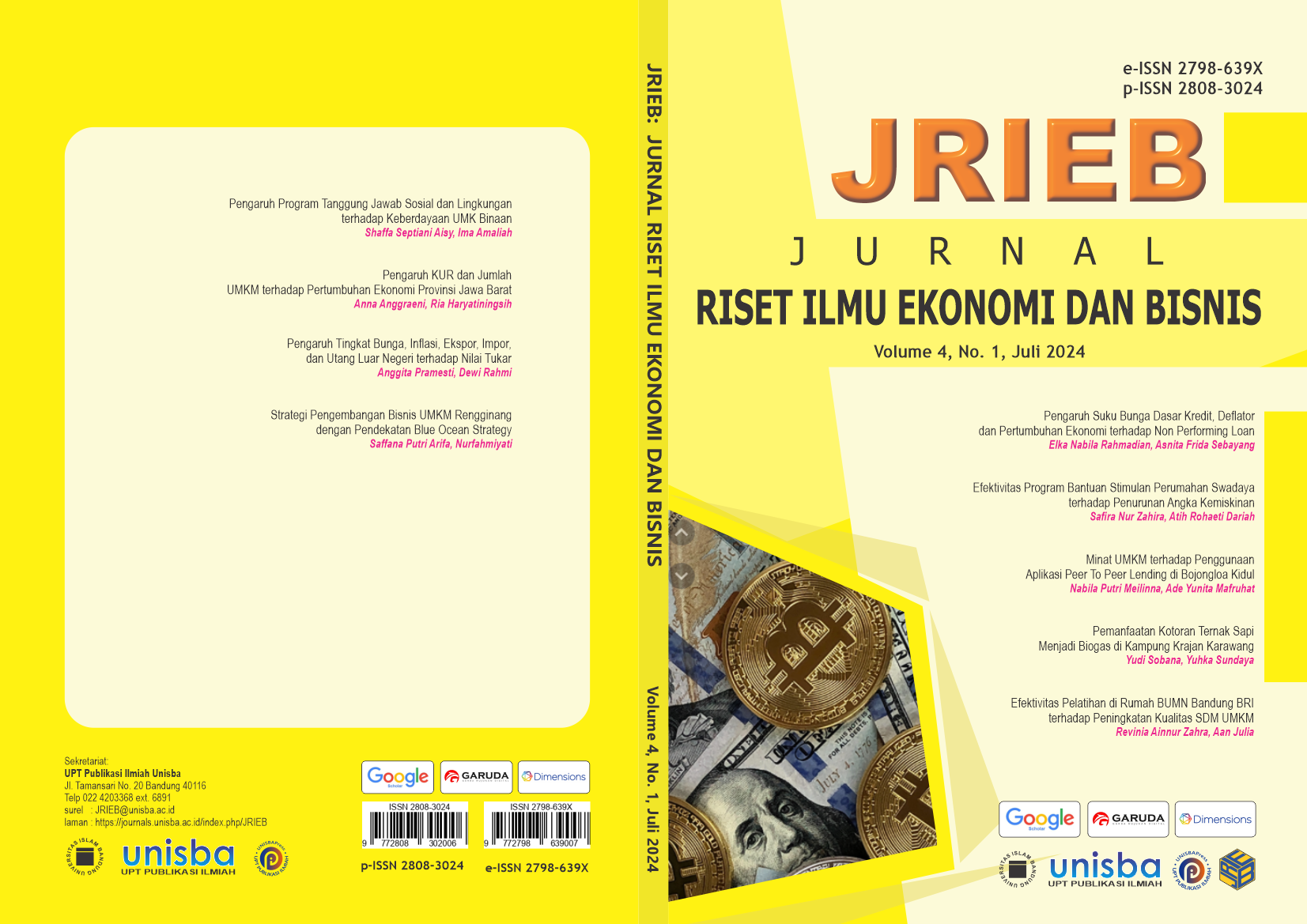Pemanfaatan Kotoran Ternak Sapi menjadi Biogas di Kampung Krajan Karawang
DOI:
https://doi.org/10.29313/jrieb.v4i1.3697Keywords:
Sumber Daya Terbarukan, Energi, Social InnovationAbstract
Abstract. This research presents the results of applying biogas production technology from cow dung in Krajan Village, Karawang Regency. His research activities involve managing the Bakti Desa Unisba student activity unit (UKM), implementation, and evaluation. In the implementation stage, biogas production was carried out by 15 people at a cost of 32 470 000 rupiah. These costs are used to purchase the equipment needed to make a biogas installation, such as bamboo, sand, cement, iron, pipes and so on. At the evaluation stage, this research uses econometric methods to identify production factors that determine post-production biogas production. The estimation results show that the temperature variable is very significant in biogas production. An increase in temperature of 1 degree Celsius can reduce biogas production by 1.75 Pascal/Kg.
Abstrak. Penelitian skripsi ini menampilkan hasil penerapan teknologi produksi biogas dari kotoran sapi di Kampung Krajan Kabupaten Karawang. Aktivitas penelitiannya melibatkan pekerjaan pengelolaan organisasi unit kegiatan mahasiswa (UKM) Bakti Desa Unisba, pelaksanaan, hingga evaluasi. Pada tahap pelaksanaan, produksi biogas dikerjakan oleh 15 orang dengan biaya sebesar 32 470 000 rupiah. Biaya tersebut digunakan untuk membeli peralatan yang dibutuhkan dalam pembuatan instalasi biogas, seperti bambu, pasir, semen, besi, pipa dan lain sebagainya. Pada tahap evaluasi, penelitian ini menggunakan metode ekonometrika untuk mengidentifikasi faktor produksi yang menentukkan produksi biogas paska produksi. Hasil estimasinya menunjukkan bahwa variabel suhu sangat signifikan terhadap produksi biogas. Kenaikan suhu sebesar 1 derajat celcius dapat menurunkan produksi biogas sebesar 1,75 Paskal/Kg.
References
Alexopoulos, S. (2012). Biogas Systems: Basics , B iogas Multifunction, Principle of Fermentation and Hybrid Application with a Solar Tower for the Treatment of Waste Animal Manure. Journal of Engineering Science and Technology Review, 5(4), 48–55. https://doi.org/10.25103/jestr.054.10
Al-Masri, M. R. (2001). Changes in biogas production due to different ratios of some animal and agricultural wastes. Bioresource Technology, 77(1), 97–100. https://doi.org/10.1016/S0960-8524(00)00117-6
Darmadi, H. (2014). Metode penelitian pendidikan dan sosial : (teori konsep dasar dan implementasi) (1st ed.).
Diynna Rahmawati, & Dr. Asnita Frida Sebayang. (2023). Pengaruh Jumlah Penduduk, Indeks Pembangunan Manusia dan Upah Minimum Provinsi terhadap Kemiskinan Ekstrem. Jurnal Riset Ilmu Ekonomi Dan Bisnis, 93–100. https://doi.org/10.29313/jrieb.v3i2.2871
Djamba, Y. K., & Neuman, W. L. (2002). Social Research Methods: Qualitative and Quantitative Approaches. Teaching Sociology, 30(3), 380. https://doi.org/10.2307/3211488
Elizabeth, R., & Rusdiana, S. (2011). EFEKTIVITAS PEMANFAATAN BIOGAS SEBAGAI SUMBER BAHAN BAKAR DALAM MENGATASI BIAYA EKONOMI RUMAH TANGGA DI PERDESAAN (Vol. 29). Prosiding Seminar Nasional Era Baru Pembangunan Pertanian: Strategi Mengatasi Masalah Pangan, Bioenergi Dan Perubahan Iklim.
Hanif, A. (2010). Studi Pemanfaatan Biogas Sebagai Pembangkit Listrik 10 Kw Kelompok Tani Mekarsari Desa Dander Bojonegoro Menuju Desa Mandiri Energi. Jurusan Teknik Elektro, Fakultas Teknologi Industri Institut Teknologi Sepuluh November.
Hardoyo, Atmodjo, M. C. T., Rosadi, D. , M. , S. C., & Lukas, A. (2018). Panduan praktis membuat biogas portabel skala rumah tangga dan industri (N. K (ed.); Dwi Bahasa) (Andi, Ed.).
Haryanto, A., Okfrianas, R., & Rahmawati, W. (2019). Pengaruh Komposisi Subtrat dari Campuran Kotoran Sapi dan Rumput Gajah (Pennisetum purpureum) terhadap Produktivitas Biogas pada Digester Semi Kontinu. Jurnal Rekayasa Proses, 13(1), 47. https://doi.org/10.22146/jrekpros.41125
Haryati, T. (n.d.). Biogas : limbah peternakan yang menjadi sumber energi alternatif.
Mujahidah, Mappiratu, & Sikanna, R. (2013). Kajian Teknologi Produksi Biogas Dari Sampah Basah Rumah Tangga (1st ed., Vol. 2). Journal of Natural Science.
Mulyatun, M. (2016). Sumber Energi Terbarukan dan Pupuk Organik dari Limbah Kotoran Sapi. Dimas: Jurnal Pemikiran Agama Untuk Pemberdayaan, 16(1), 191. https://doi.org/10.21580/dms.2016.161.898
Nadliriyah, N., & Triwikantoro. (2014). Pemurnian Produk Biogas dengan Metode Absorbsi Menggunakan Larutan Ca(OH)2 (2nd ed., Vol. 3). Jurnal Sains Dan Seni Pomits.
Pertiwiningrum, A. (2016). Instalasi Biogas (1st ed., Vol. 1).
Polprasert, C. (2015). Organic Waste Recycling. Water Intelligence Online, 6(0), 9781780402024–9781780402024. https://doi.org/10.2166/9781780402024
Ramadhany, M. N. (2019). Analisis Faktor-Faktor yang Mempengaruhi Tingkat Migrasi Keluar Masyarakat Kab/Kota Madura.
Saputri, Y. F., Yuwono, T., Mahmudsyah, S., Sebagai, B., & Energi, S. (2014). Pemanfaatan Kotoran Sapi untuk Bahan Bakar PLT Biogas 80 KW di Desa Babadan Kecamatan Ngajum Malang (1st ed., Vol. 1). Jurnal Teknik Pomits.
Sugiyono. (2014). Metode Penelitian Pendidikan Pendekatan Kuantitatif, Kualitatif, dan R&D. .
Sukmana, R. W., & Muljatinigrum, A. (2016). Biogas dari limbah ternak (Mathori A. Elwa (ed.); 2nd ed.). .
Sunaryo. (2014). Uji Eksperimen Pemurnian Biogas Sebagai Pengganti Bahan Bakar Motor Bensin. Jurnal PPKM II.
Sutarno, S. (2007). Analisis Prestasi Produksi Biogas (Ch4) Dari Polyethilene Biodigester Berbahan Baku Limbah Ternak Sapi. Logika, 4(1). https://doi.org/10.20885/logika.vol4.iss1.art3
Suyitno, Nizam, M., & Darmanto. (2010). Teknologi Biogas.
Uddin, W., Khan, B., Shaukat, N., Majid, M., Mujtaba, G., Mehmood, A., Ali, S. M., Younas, U., Anwar, M., & Almeshal, A. M. (2016). Biogas potential for electric power generation in Pakistan: A survey. Renewable and Sustainable Energy Reviews, 54, 25–33. https://doi.org/10.1016/j.rser.2015.09.083
Umeghalu., C. E., Chukwuma, E. C., Okonkwo, I. F., & Umeh, S. O. (2012). Potentials for Biogas Production in Anambra State of Nigeria Using Cow Dung and Poultry Droppings (1st ed., Vol. 1). International Journal of Veterinary Science .













